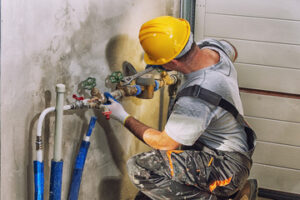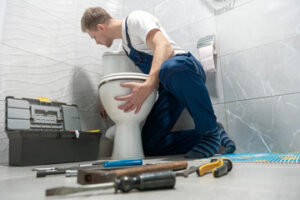Plumbers Sarasota install, repair, and maintain pipes that carry water, waste, and gases throughout homes and businesses. They read blueprints and building codes to plan pipe layouts and systems, and they use specialized tools to inspect and troubleshoot plumbing problems.

Plumbers must have excellent listening skills to understand their clients’ issues and determine how best to fix them. They also need to be comfortable working with their hands and in confined spaces.
One of the most common issues that plumbers deal with is fixing dripping faucets. This is a major nuisance for homeowners, as it wastes water and money and can lead to further problems with pipes and other fixtures in the home. Fortunately, most dripping faucets can be fixed with simple tools and supplies that are available at any hardware store. In some cases, however, the problem may be more serious and require the expertise of a professional plumber.
The first step in fixing a leaky faucet is to turn off the water supply valve. This is usually located under the sink or near the wall where the faucet is leaking. It is important to shut off the water before starting work on a faucet because it will prevent any accidental flooding while you are working.
Once the water is turned off, the next step is to remove the faucet handles and packing nut. You may need to use a screwdriver or Allen wrench to loosen the handle screws. Once the handles are removed, you can access the packing nut and stem. It is important to clean these parts as you go, as they will often collect water sediments that can lead to further drips. A good idea is to use white vinegar, as this will help remove any buildup and leave the parts in a cleaner condition.
After removing the packing nut and stem, you will need to replace the O-ring and seat washer. This is a fairly straightforward process and should be easy to do, even for novice plumbers. The O-ring is usually a rubber material that will need to be replaced, and the seat washer is a small disk that sits on top of the valve stem. It is important to ensure that the new O-ring and seat washer are correctly installed, as a poor fit can cause leaks.
After replacing the O-ring and seat washer, it is a good idea to tighten the adjusting ring with a spanner tool that should be included in your repair kit. This will ensure that the spout is properly sealed and that no more water is escaping from the spout. Finally, you can reassemble the faucet and test it for any remaining leaks. If there are no leaks, you can turn the water back on and enjoy your newly repaired faucet!
Replacing the Seat
The valve seat, or washer, is the part that allows water to flow through the faucet. If an inspection reveals nicks or other damage to the seat, you may need to replace it. You can buy replacement seats at most plumbing supply outlets. To remove the old one, first turn off your water supply by turning the valves under your sink. Then, you’ll need a wrench with either a hexagonal or square tip to unscrew the seat. You may also be able to take the seat to a machinist to have it reground, but you’ll probably just be better off buying a new one.
Replacing the Cylinder
Generally, plumbers install and repair the pipes that supply water and gas to, or carry waste away from, homes and businesses. They may specialize in specific types of pipes, fixtures or appliances, and must be familiar with local building codes and regulations. Plumbers often work with their hands, using tools to open and close valves and to cut, bend and join pipe sections together. They also use specialized tools to detect and repair leaks, such as augers, snakes and hydro jets. Some plumbers choose to pursue professional certification, which can improve their career opportunities and earnings.
Plumbers must have strong customer service skills to interact with clients, as they may be called upon to explain complex plumbing issues and solutions. They must be able to listen carefully to the customer’s concerns and answer questions clearly and concisely. Customers often feel stressed and upset when their plumbing systems break down, so the plumber must be understanding and empathetic.
Plumbers must have a high school diploma or equivalent and undergo extensive on-the-job training through an apprenticeship program, which can last from two to five years. After completing the apprenticeship, they must pass an exam to become licensed plumbers. Licensing requirements vary by jurisdiction, but typically include passing an exam on plumbing codes and regulations. Plumbers who wish to advance in their careers can pursue additional certifications, such as becoming certified in green plumbing practices or working with particular types of equipment. Some plumbers also belong to unions, which can help them negotiate wages and benefits. Many states and cities require plumbers to complete continuing education courses to keep their licenses valid. In New York, for example, master plumbers must complete seven hours of continuing education each year to renew their licenses. This ensures that they remain current on changes to the state’s plumbing code. Those who do not take continuing education courses risk having their licenses revoked. In addition, some plumbers choose to join trade organizations, which can help them stay informed about industry trends and developments. These organizations often have online resources, blogs and podcasts that can be useful to their careers.
Replacing the Handle
Plumbers are skilled tradespeople who specialize in the installation, repair, and maintenance of plumbing systems. These systems facilitate the distribution of water, gas, and waste in residential and commercial buildings. They ensure that these systems function properly, allowing for a clean water supply, proper drainage, and safe operation of appliances like washing machines and dishwashers. Plumbers usually undergo extensive hands-on training through an apprenticeship or a trade school program before they become licensed. They are also required to adhere to specific safety protocols when working with hazardous materials or in confined spaces.
While some of the main responsibilities of a plumber involve repairing existing plumbing systems, others work on new construction projects. In this role, they follow blueprints and architectural plans to lay out piping systems, install fixtures and appliances, and connect them to water supply and drain lines. They may also use specialized equipment to inspect pipes for leaks or other issues, such as video cameras and pressure gauges.
One of the most important qualities of a plumber is their ability to solve problems. Whether they’re diagnosing a leak, unclogging a drain, or determining why a faucet is leaking, plumbers must be able to think analytically and approach each problem systematically to come up with effective solutions. This requires excellent communication skills, as plumbers often interact with customers directly to explain complex issues and receive feedback on their work.
Depending on the type of plumbing system, plumbers may need to perform routine maintenance on their tools. For example, some plumbing systems require periodic flushing to remove sediment from the pipes. Others may need to be re-plumbed or replaced entirely due to age or damage. Plumbers must keep up to date on the latest tools and technology in their field, as well as the latest building codes and regulations.
A career as a plumber can be highly rewarding for individuals who enjoy working with their hands, solving problems, and providing essential services to the community. Plumbers must complete extensive hands-on training through an apprenticeship or trade school program before they can be licensed, and they must continue to gain experience in the field to remain competitive as professionals. In addition, some cities and states require plumbers to obtain additional certifications or continuing education credits to maintain their licenses.

